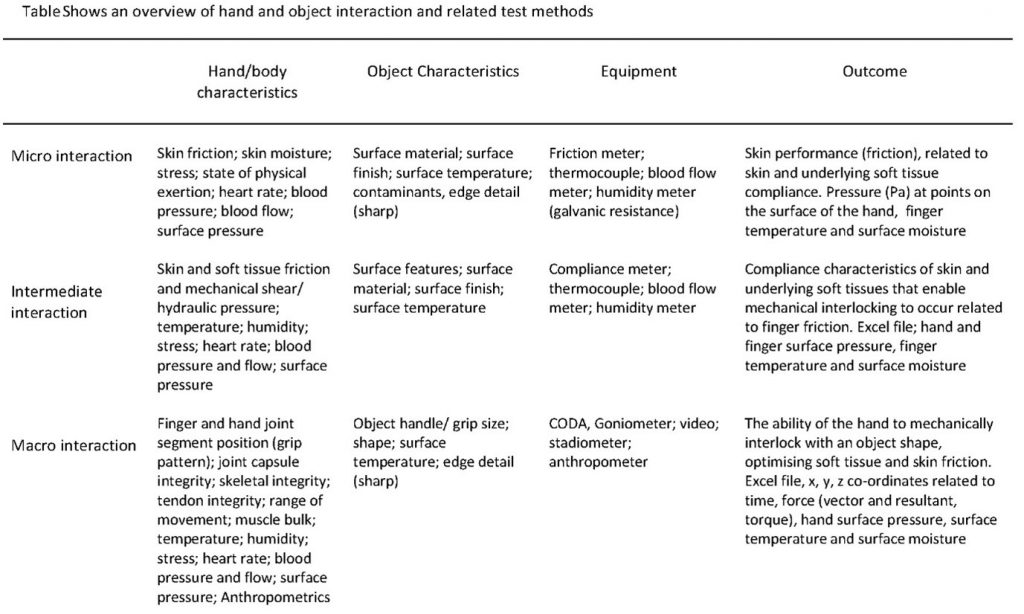A model of human and object physical interaction (HOPI) has been developed to provide a more detailed understanding of how we control or environment and how to optimise the interface.
There are a number of explanations of aspects of hand and object interaction. The explanations document different levels of the interaction, from the macro of task analysis by Guo, Genaidy, Christiansen and Huntington (1996) to micro interaction at an biomechnical level by Gielo-Perczak (1994). Structures of interaction documented by Sperling, Dahlman, Wikstrom, Kilbom, Kadefors (1993) and Drury (1985), Hsia and Drury CG (1986) provide understanding of hand and object interaction based on mainly observation and biomechanics respectively.
Hand and object interaction is a description of the primarily static connection (grip) between a hand and an object formed for the purpose of the performance of a task. Due to the complexity of hand and object interaction a description of the interaction is based upon a specific moment during a task performance.
Static grip is critical to the user’s perception of comfort and ease of use. If an object slips within a user’s hand they will increase their grip until slippage stops. Conversely, a user will reduce their applied grip force until the object reaches a point just before slippage occurs (Edin, Westlin and Johansson, 1995). A product that enables a static grip to be produced that requires a minimum of grip strength to maintain it will be perceived as easy to use.
There are three levels of interaction:
- Gross interaction, where a grip pattern made by the user to resist the forces acting through the object handle. A grip pattern relies heavily on the ability of the user to be able to move their fingers and thumb into the required positions. Mobility of joints and muscle strength are required to achieve this objective.
- Intermediate interaction, where the soft tissues of the hand interlock with the coarse surface features of the object.
- Micro interaction, where the skin surface interacts with the fine surface features of the object. The interaction is primarily a form of adhesion. The adhesive is a combination of the sweat (sebum) and the dead skin layer (epidermis).

Useful links
Brown F.R., Torrens G.E., Wright D.K. , Research into optimising hand and body function for tasks in everyday living: the development of a range of “easy use” saucepan handles, In Bracale M. and Denoth F. (ed), Number 1, Medicon ’92, Proceedings of the VI Mediterranean conference on medical and biological engineering (Associazione Italiana di Medica e Biologica, Napoli) 1992, pp549-553
Buck R, Greatorex G, Development of a human factors task database for human performance evaluation, Contemporary Ergonomics(Annual conference of the Ergonomics Society, University of Leicester), London:Taylor Francis 1996, pp275-280 ISBN 07484 05496
Drury CG, The role of the hand in manual materials handling, Ergonomics, Number 1, London: Taylor Francis, 1985, pp213-227
Blair VA, 1999 in Functional human movement: measurement and analysis, (Ed)Durward BR, Baer GD, Rowe PJ, Butterworth-Heinemann, Oxford ISBN 0 7506 2607 0 p160-179
Edin B., Westling G., Johansson R.S., , Independent control of human finger-tip forces at individual digits during precision lifting, Journal of Physiology, Number 450, 1992, pp547-564.
Gielo-Perczak K, Advances in Biomechanics of the Hand and Wrist, Schuind F, An KN, Cooney WP, Garcia-Elias M (Ed), NATO ASI Series A, 256, London: Plenum Press, 1994, pp123-135
Guo L, Genaidy A, Christiansen D, Huntington K, Macro-ergonomic risk assessment in nuclear remediation industry, Applied Ergonomics, Number 4 , London: Elsevier Science, 1996, pp 241-254
Hamilton, Mcdonald, Chenier, Measurement of grip strength: Validity and reliability of the sphygmomanometer and the Jaymar grip dynomometer, Journal of Orthopaedic and Sports Physical Therapy, Number 5, 1992 pp215-219
Hsia PT, Drury CG, , A simple method of evaluating handle design, Applied Ergonomics, Number 3 , London: Elsevier Science, 1986, pp209-213
Harkonen R, Piirtomaa M, Alaranta H, 1993, Grip strength and hand position of the dynamometer in 204 Finnish adults, Journal of Hand Surgery, Number 1, pp129-132
Jones AR, Unsworth A, Haslock I, Functional measurements in the hands of patients with Rheumatoid Arthritis, International Journal of Rehabilitation Research, Number 4, 1987, pp62-72
Kadefors R, Areskoug A, Dahlman S, Kilbom A, Sperling L, Wikstrom L, Oster J, , An approach to ergonomics evaluation of hand tools, Applied Ergonomics, Number 3, London: Elsevier Science, 1993, pp203-211
Kilbom A, Makarainen M, Sperling L, Kadefors R and Liedberg L, Tool design, user characteristics and performance: a case study on plate-shears, Applied Ergonomics, London:Elsevier Science, , 1993, pp221-230
MacKenzie C.L. and Iberall T., The grasping hand; Advances in psychology Number 104, Stelmach G.E. and Vroon P.A. (ed.), Amsterdam: North-Holland, 1994, pp222-235.
Napier JR, The prehensile movements of the human hand, Journal of bone and Joint Surgery, Number 38:B, 1956 p902
Shah S, Cooper B, Commentary on a critical evaluation of the Barthel Index, The British Journal of Occupational Therapy, Number 2, 1993, pp70-72
Surburg PR, Suomi R, Poppy WK, Validity and reliability of a hand held dynamometer with two populations, Journal of Orthopaedic and Sports Physical Therapy, Number 5, 1992, pp229-234
Torrens GE, A contribution to the understanding of the role of digital pulp in hand grip performance, Robertson SA (Ed), Contemporary Ergonomics, (Annual conference of the Ergonomics Society, University of Leicester), London: Taylor Francis 1996, pp75-80 ISBN 0 7484 0549 6
Torrens GE, The development and evaluation of a saucepan used by people with Rheumatoid Arthritis by the use of an optimised specification, 1997a, Unpublished
Torrens G E (1997) What is the optimum surface feature? Contemporary Ergonomics, Robertson S A (ed), London: Taylor & Francis pp 314-319.
Torrens G E and Gyi D E (1999) Towards the integrated measurement of hand and object interaction, Proceedings of the 7th International Conference on Product Safety Research, US Consumer Product Safety Commission, Washington, USA pp 217-226, ISBN 90-6788-251-
Torrens G.E., Kay G., Design for Physical Disability: A Discussion of Research and Development Methods Through to a Commercial conclusion, Design Interfaces, (Inaugural Conference of the European Academy of Design, University College Salford, University of Salford, Salford, U.K. Proceedings: Number 1, Product Design,Graphic Design),11 April 1995, ISBN 0 9525666 1 3
Williams M. and Lissener H.R., , Williams and Lissener’s biomechanics of human motion, 3rd ed, LeVeau B.F.(ed.), Philadelphia:Saunders, 1991
Wood Jones F., The principles of anatomy as seen in the hand, 2nd ed, London:Bailliere, Tindal and Cox, 1941, pp166-167.Bobjer O (1989) Ergonomic Knives, Advances in Industrial Ergonomics and Safety I, Edited by A Mital, London: Taylor & Francis pp 291-298.
